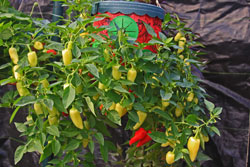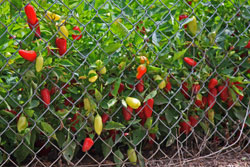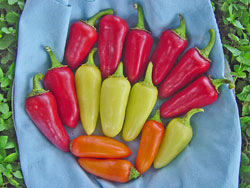|
Non-pungent banana peppers, sweet jalapenos such as ‘Rio Grande Gold’ and sweet cherries are members of Capsicum annuum. Currently capsicum includes at least 25 species, four of which are domesticated. Sweet peppers are called sweet because they do not produce capsaicin–a chemical that causes a “burning” sensation when hot peppers are consumed. Sweet peppers lack capsaicin due to a recessive form of a gene that eliminates capsaicin and, consequently, the “hot” taste usually associated with the rest of the capsicum genus.
Dr. Ben Villalon, retired Texas A&M Experiment Station in Weslaco Virologist has created the no-complaints-possible pepper. It is the most versatile pepper ever. It is named TAM Rio Grande Gold. The fruit of this pepper is jalapeno - shaped and about twice the size of a large jalapeno. When the pepper plant sets fruit, the fruit is yellow. If left on the plant for several weeks the yellow fruit ripens to red. The peppers are sweet and can be used as a substitute for yellow or red Bell pepper to beautify cookery. "But," say you chronic complainers, "we want a jalapeno!" If you want to create a pickled jalapeno which is custom-designed to your heat-tolerance level, now is your chance.
Most people think that the heat of a pepper is associated with the seed. This is wrong! The tongue-twisting heat compound, capsaicin, is located primarily in the cross wall portion of the fruit. This is not to say that eating individual seeds may not "burn your innards" but the seeds which are "hot" were contaminated with capsaicin during processing. All processed pepper parts seem to contain much higher capsaicin levels than do raw pepper parts. This may be attributed to the thermal processing during pickling which allows capsaicin to spread freely throughout the fruit. It is also believed that the processing oil (sesame, soybean, etc.) tends to withdraw or release capsaicin from the fruit and into the pickled or "escabeche" juice. Using this process of the heat-compound movement and dilution throughout a container during pickling, you can create a custom-designed-heat-level jalapeno using Rio Grande Gold fruit. Simply harvest Rio Grande Gold peppers, prepare them for pickling, and before sealing the container put one (or some) regular, hot jalapenos on the top as inoculator fruits. The capsaicin (heat-causing substance) will spread to the rest of the peppers. The heat-providing pepper fruit at the top of the jar does not have to be cut. One hot pepper in a quart of Rio Grande Gold fruit should result in a mild finished product. Two hot peppers added equals burning lips to remember. For you tender- tongued types, I recommend that you substitute TAM Mild jalapenos for your inoculator peppers. Not only will you have a pepper designed for your taste but you will also have the first brightly colored jalapenos in town!
MOST IMPORTANT CHARACTERISTIC ABOUT THIS PEPPER: The BEST thing about this bell-pepper substitute is that it is completely belch-less. Some people cannot eat bell peppers because of the serious stomach problem and subsequent belching which occurs. The sweet taste from all bell peppers comes from raffinose (a combination of three sugar molecules). Raffinose is notoriously hard to digest it requires an enzyme called alpha galactosides which we don't produce. However, the bugs in our gut do -- and they love raffinose. It is a good source of energy for them so they get very active (and gas producing) when it is available. Obviously, the sweetness of the ‘Rio Grande Gold' pepper is NOT generated by raffinose so NO BELCHING occurs.
Height: 18-24 inches;
Spacing: 18-24 inches;
Sun Exposure: Full Sun;
Heat (Pungency): Sweet (0 Scoville Units);
Fruit Shape: Tapered;
Fruit Size: Pods are jalapeno-shaped but about twice the size - Medium (4 inches to 6 inches in length);
Fruit Color: Bright yellow changing to deep orange then red fruit;
Disease Resistance: Tobacco Mosaic Virus (TMV), Potato Virus Y (PVY), Tobacco Etch Virus (TEV), Pepper Mottle Virus (PepMV);
Usage: Fresh (salsa, salads, bell pepper replacement)
For further information about peppers, see:
http://plantanswers.com/Resources/Vegetable/E-515_peppers.pdf
For a bell pepper, we are recommending ‘Rio Grande Gold.’ Even though it is Jalapeno-shaped, it is in reality a BELCH-LESS Bell Pepper. Dr. Ben Villalon, retired Plant Pathologist and pepper breeder for the Texas AgriLife Experiment Station in Weslaco, Texas, created the no-complaints-possible pepper. It is the most versatile pepper ever. The fruit of this pepper is jalapeno - shaped and about twice the size of a large jalapeno. When the pepper plant sets fruit, the fruit is yellow. If left on the plant for several weeks the yellow fruit ripens to orange, then red. It has ornamental value as well as culinary uses. The peppers are sweet and can be used as a substitute for yellow or red Bell pepper to beautify cookery. It is a better choice than a Bell pepper since some people cannot eat bell peppers because of the serious stomach problem and subsequent belching which occurs.
The sweet taste from all bell peppers comes from raffinose (a combination of three sugar molecules).
Raffinose is notoriously hard to digest as it requires an enzyme called alpha galactosides which we don't produce. However, the bugs in our gut do -- and they love raffinose. It is a good source of energy for them so they get very active (and gas producing) when it is available. Obviously, the sweetness of the ‘Rio Grande Gold' pepper is NOT generated by raffinose so NO BELCHING occurs. "But," say you chronic complainers, "we want a jalapeno!"
If you want to create a pickled jalapeno (recipe at: http://www.plantanswers.com/garden_column/apr03/3.htm) which is custom-designed to your heat-tolerance level, now is your chance. Simply add one hot pepper (no need to slice!) to the top of a jar of these sweet jalapeno-shaped, colorful peppers before pickling or processing, and ALL of the peppers will become "hotter" comparable to the heat level of the pepper in the top of the jar. Characteristics of this sweet yellow wax type ‘Rio Grande Gold’ pepper is a strong main stem, sturdy branches and fruit-set at high temperature.

Rio Grande Gold Peppers growing in a container.
|

Rio Grande Gold Peppers growing in a garden.
|

Color Changes of Rio Grande Gold Pepper fruit.
|
|
|



